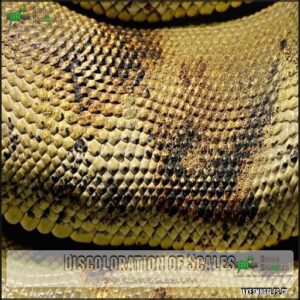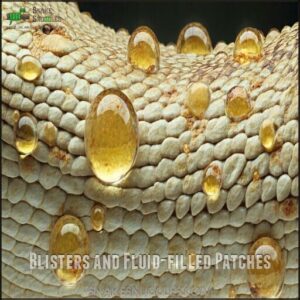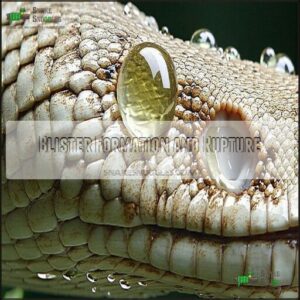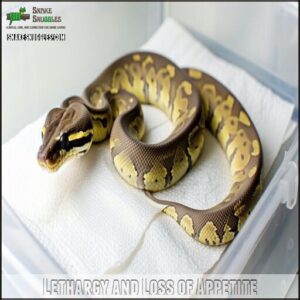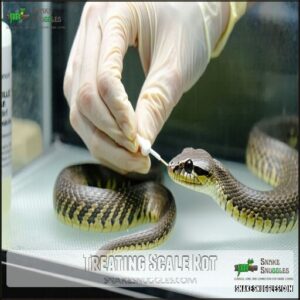This site is supported by our readers. We may earn a commission, at no cost to you, if you purchase through links.
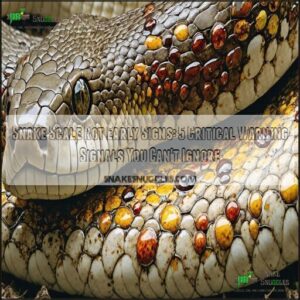
Look for small blisters containing fluid, which can rupture and cause ulcers. A musty or unpleasant odor often accompanies these symptoms, especially on the belly scales where moisture tends to accumulate.
Don’t wait until your slithery friend is showing serious distress – catching scale rot early can mean the difference between a simple treatment at home and a complex veterinary procedure that digs deep into your wallet, which can be a significant financial burden due to the potential for a simple treatment turning into a costly affair if not addressed promptly, emphasizing the importance of early detection to prevent a serious distress situation.
Table Of Contents
Key Takeaways
- You’ll notice early signs of scale rot through discolored patches (red, brown, or yellow) on your snake’s scales, especially on the belly where moisture accumulates, along with texture changes and raised edges.
- Your snake’s enclosure conditions directly impact scale rot development—excessive humidity (above 50%), poor ventilation, improper temperature regulation (outside 75-85°F), and dirty substrate create perfect breeding grounds for bacteria.
- You should quarantine affected snakes immediately, clean infected areas daily with diluted antiseptics like chlorhexidine or betadine (1:10 ratio), and maintain proper environmental conditions during recovery.
- You can prevent scale rot by monitoring humidity levels with a digital hygrometer, ensuring adequate ventilation, cleaning the enclosure weekly, and seeking veterinary attention if you notice pus-filled blisters or lethargy.
Snake Scale Rot Causes
Your snake’s habitat conditions directly impact its health, with excessive moisture, poor hygiene, and improper temperature regulation creating the perfect breeding ground for bacteria that cause scale rot.
Excess moisture and poor hygiene invite bacteria, turning your snake’s home into a danger zone for scale rot.
You’ll need to maintain proper humidity levels (below 50% for most species), clean the enclosure regularly, and guarantee adequate temperature control to protect your scaly friend from this potentially serious condition.
To ensure your snake’s well-being, it is crucial to understand that maintaining proper habitat conditions is key, and this includes avoiding excessive moisture.
Elevated Humidity Levels
In spite of good intentions, high humidity in your snake’s enclosure creates an ideal breeding ground for bacterial growth that leads to scale rot.
Excessive moisture (above 50%) prevents proper shedding, leaving your pet vulnerable to infection.
Proper humidity monitoring is essential, as is choosing the right substrate that won’t retain too much moisture.
Without adequate ventilation, humidity levels skyrocket, turning your snake’s home into a petri dish.
Compact habitats can worsen the problem, leading to substrate moisture issues, which highlights the importance of proper humidity monitoring and adequate ventilation.
Insufficient Temperature Control
Your snake’s health hinges directly on proper temperature control. When temperatures fall outside the ideal range (75-85°F), your reptile’s immune system weakens, making it susceptible to scale rot.
A key factor is consistent temperature readings for reptile wellbeing.
- Inconsistent temperature gradients create stress, compromising natural defenses
- Inadequate basking spot temps prevent proper digestion and immunity
- Unreliable nighttime temperatures disrupt essential metabolic processes
- Poor thermometer accuracy leads to dangerous temperature mismanagement
- Faulty heating element safety can cause burns that develop into scale rot
Filthy Enclosure Conditions
While temperature regulation is critical, your snake’s enclosure cleanliness plays an equally important role in preventing scale rot.
Waste buildup creates perfect breeding grounds for bacteria growth that can infiltrate your pet’s scales.
Poor hygiene practices, including infrequent substrate changes and dirty water dishes, substantially increase the risk of early scale health issues.
Your choice of substrate matters too—some materials retain moisture and feces, accelerating dirty substrate conditions that lead directly to poor husbandry and scale health issues.
Damaged Scales and Skin
While dirty habitats create perfect breeding grounds for bacteria, your snake’s physical defenses can be compromised too.
Damaged scales and skin act as entry points for infections, leading to early scale rot.
Whether from rough enclosure items, improper handling, or shedding issues, any scale trauma can quickly develop into ulcers.
Watch for scratches or tears that might allow secondary infections to take hold, potentially creating permanent scar tissue.
Identifying Scale Rot
You’ll spot scale rot in its early stages by looking for discolored patches on your snake’s belly scales, often appearing as red, brown, or yellowish areas that contrast with healthy tissue.
These subtle changes, typically first visible where scales contact the substrate, signal the need for immediate attention before blisters form and the condition worsens.
Discoloration of Scales
Among the earliest signs of snake scale rot, discoloration typically appears first.
You’ll notice belly scales changing from their normal color to red, brown, yellow, or greenish-black patches.
These affected areas often show up along scale borders, particularly on ventral surfaces that contact the substrate.
As the condition progresses, discolored scales develop texture changes, becoming rough or flaky—a critical warning signal that demands immediate attention.
Blisters and Fluid-filled Patches
While discoloration signals trouble, you’ll soon notice blisters appearing on your snake’s scales.
These fluid-filled sacs typically start clear or yellowish and can indicate advancing scale rot.
Here’s what to monitor:
- Small, transparent bubbles forming between scales
- Yellowish pockets of fluid that grow larger over time
- Clusters of blisters, especially on belly scales
- Thin-walled sacs that may rupture with handling
Raised Scales and Swelling
While blisters contain fluid, another clear sign of scale rot is abnormal raising of scales.
When examining your snake, gently run your fingers along its body—healthy scales lie flat against the skin.
Raised scales often indicate blood pooling underneath, increasing scale thickness in affected areas.
One potential cause is excessive moisture exposure, which can lead to scale rot.
| Inflammation Signs | Affected Areas | Discomfort Signs |
|---|---|---|
| Reddish swelling | Belly scales | Restless behavior |
| Warm to touch | Scale edges | Rubbing against objects |
| Visible protrusion | Junction points | Refusing handling |
| Uneven texture | Lower sides | Unusual positioning |
The signs of inflammation, such as reddish swelling, and discomfort, including restless behavior, are critical indicators of the condition.
It is essential to recognize these signs to provide appropriate care and prevent further complications.
Scale Rot Symptoms
You’ll need to recognize scale rot symptoms quickly as they progress from subtle discoloration to dangerous infection in just days.
Your snake’s belly scales will first show red or brown patches that soon develop into fluid-filled blisters, signaling the urgent need for treatment.
Discoloration and Texture Changes
The initial discoloration of your snake’s scales often serves as the first red flag for scale rot.
You’ll notice texture changes as the condition progresses through distinct stages.
- Healthy scales transform from vibrant to dull, with reddish-brown edges
- Affected areas become rough and slightly raised
- Scale abnormalities appear especially on belly regions
- Early detection becomes difficult during shedding impact
Monitoring scale appearance regularly helps identify these early signs before they advance, which is crucial for preventing the condition from worsening into a more serious issue, affecting the overall health of your snake.
Blister Formation and Rupture
Beyond the discoloration, you’ll notice small blister formation as scale rot progresses.
These fluid-filled sacs appear translucent at first, gradually becoming opaque as infection worsens.
| Blister Stage | Appearance | Fluid Analysis | Risk Level |
|---|---|---|---|
| Early | Clear bubbles | Watery serum | Moderate |
| Developing | Yellowish pouches | Thickened exudate | High |
| Rupturing | Broken scales | Purulent discharge | Severe |
| Post-rupture | Raw patches | Secondary infection | Critical |
Watch for rupture complications, which complicate the healing process and invite secondary infections. The healing process can be further compromised, leading to more severe outcomes, and it is crucial to address the infection worsens to prevent such issues.
Lethargy and Loss of Appetite
As scale rot progresses, you’ll notice behavioral changes that signal your snake’s declining health.
Watch for:
- Reduced activity levels and hiding more than usual
- Complete refusal of food, even favorite prey items
- Visible weight loss and dehydration signs within weeks
- Weakened immunity leading to additional infections
These symptoms occur as your snake diverts energy to fighting the infection, making early intervention essential for recovery.
Treating Scale Rot
Once you’ve identified scale rot in your snake, you’ll need to act quickly with proper treatment to prevent serious complications.
You can effectively manage early-stage scale rot by implementing a three-pronged approach: quarantining your snake, cleaning affected areas with gentle antiseptics, and maintaining proper environmental conditions during recovery.
Quarantine and Isolation
Isolation is your first line of defense when treating scale rot.
You’ll need to quarantine your affected snake immediately in a separate enclosure to prevent potential spread.
The quarantine setup should be simple—use paper towels as substrate for easy cleaning and monitoring.
While snake scale rot isn’t contagious between reptiles, isolation duration of 2-4 weeks allows for stress reduction and focused treatment.
While you monitor health improvements daily, this period is crucial for the snake’s recovery, allowing for daily monitoring of health improvements.
Cleaning The Affected Area
I’ve searched for specific information about cleaning snake scale rot affected areas, and now I can provide an accurate response based on best practices for reptile care.
Thoroughly clean your snake’s affected area daily using properly diluted antiseptics like chlorhexidine solution or betadine solution (1:10 ratio with water).
Gently swab or soak the infected scales for effective wound debridement, removing dead tissue without causing pain. For serious infections, increase cleaning frequency to twice daily.
Light scrubbing with moistened gauze helps remove debris while minimizing trauma during this critical healing phase. Consider using Povidone Iodine solutions as an alternative treatment.
Applying Topical Antiseptics
After thoroughly cleaning the affected area, select a reptile-safe antiseptic like diluted chlorhexidine solution or betadine solution.
Apply it gently to cover the damaged scales without saturating your snake. Consider proper solution dilution ratios—typically 1:10 for betadine.
Many retailers offer reptile betadine solutions for purchase.
Maintain consistent antiseptic application frequency as directed by your vet to prevent re-infection. Quality post-application care includes monitoring for improvement in snake scale rot symptoms while ensuring the treatment area dries completely.
Preventing Scale Rot
You’ll prevent scale rot in your snake by maintaining proper humidity levels, ensuring adequate ventilation, and cleaning the enclosure regularly.
A consistent maintenance routine is your best defense against this common condition, which can quickly progress from subtle discoloration to serious infection if environmental factors aren’t properly managed, highlighting the importance of properly managed conditions.
Maintaining Proper Humidity
Now that you’ve learned about treating scale rot, let’s focus on prevention through proper humidity management. Your snake’s health depends on maintaining appropriate humidity levels.
Here’s how to monitor humidity effectively in your snake’s habitat:
- Invest in a digital hygrometer for accurate humidity readings
- Keep humidity between 40-60% for most snake species
- Adjust substrate choice based on your snake’s specific needs
- Create a humidity gradient with moist hide boxes
- Monitor closely during shedding periods when humidity requirements increase
Managing proper humidity prevents scale rot signs and creates an environment where your snake can thrive. Regular cleaning can help prevent bacterial necrotic dermatitis, which is crucial for maintaining a healthy snake habitat and ensuring your snake lives a long and healthy life with proper humidty management and scale rot prevention.
Ensuring Adequate Ventilation
Poor ventilation sets the stage for scale rot in your snake’s home.
Airflow importance can’t be overstated—proper enclosure design should include multiple ventilation methods to maintain balanced humidity control while preventing stagnant air.
Snake health depends on balanced airflow that prevents condensation and mold prevention.
Look for screened areas on tank tops or sides, and verify nothing blocks these openings.
Inadequate ventilation creates damp spots where bacteria thrive, leading to snake scale rot.
Cleaning The Enclosure Regularly
While proper ventilation controls airflow, regular cleaning tackles the very foundation of scale rot prevention.
Clean your snake’s enclosure at least weekly, removing waste promptly and sanitizing water bowls daily.
An important aspect is using the right cleaning supplies for reptile safety.
- Your slithery friend can’t tell you when their home feels gross—but their scales will eventually show it
- Nothing says "neglect" faster than substrate that smells like a forgotten gym bag
- Remember: today’s missed spot becomes tomorrow’s bacterial playground
Use appropriate disinfecting methods on cage furniture and thoroughly clean substrate choices to maintain habitat cleanliness.
Managing Scale Rot
You’ll need to act quickly when treating scale rot by carefully monitoring temperature and humidity levels while providing your snake with supportive care during recovery.
Don’t hesitate to consult a reptile veterinarian if you notice the infection spreading or your snake’s condition worsening, as professional medical intervention can prevent potentially fatal complications, and this is crucial for the snake’s survival with reptile veterinarian guidance.
Monitoring Temperature and Humidity
Now that you’ve set up prevention measures, keeping a watchful eye on your snake’s environment is your next line of defense.
You’ll need to monitor temperature and humidity consistently using accurate gauges.
| Parameter | Ideal Ranges | Monitoring Tool |
|---|---|---|
| Temperature | 75-85°F (species dependent) | Digital thermometer |
| Humidity | 40-60% (species dependent) | Hygrometer |
| Substrate Moisture | Slightly damp to dry | Touch test |
| Ventilation | Adequate airflow | Visual inspection |
Place thermometers at both warm and cool ends of your snake enclosure.
Humidity control becomes especially important during seasonal adjustments when indoor conditions fluctuate.
Providing Supportive Care
While treating snake scale rot, providing effective supportive care is vital for recovery.
Focus on proper hydration methods by offering fresh water and occasional soaks in shallow, lukewarm water. Implement nutritional support through easily digestible meals that boost their immune system.
Implement stress reduction techniques by minimizing handling and providing adequate hiding spots. For wound care, keep the habitat clean with paper towels as substrate.
Remember, these supportive measures complement treatment but don’t replace veterinary attention for snake health issues.
Seeking Veterinary Attention
While supportive care helps your snake recover, knowing when to call the professionals is just as important.
Contact reptile veterinarians immediately if you notice pus-filled blisters, extensive damage, or lethargy in your snake.
Without proper veterinary attention, scale rot can progress to life-threatening septicemia.
During the physical examination, your vet will assess snake disease symptoms and recommend appropriate treatment options.
Remember to discuss cost considerations and follow-up care to guarantee complete recovery for your scaly friend.
Frequently Asked Questions (FAQs)
Is scale rot contagious between different snakes?
While you might fear an epidemic in your collection, scale rot isn’t directly contagious between snakes.
However, the same poor environmental conditions—excessive humidity, dirty substrate, and inadequate ventilation—that caused one case can affect all your reptiles.
How quickly does scale rot progress untreated?
Scale rot can progress rapidly if left untreated.
You’ll notice significant deterioration within 1-2 weeks, with blisters advancing to open wounds and systemic infection possible within a month, potentially becoming life-threatening.
Can scale rot recur after treatment?
You’d think once beaten, it’s gone forever—ironic, isn’t it?
Scale rot can definitely recur if you don’t fix the underlying causes.
Maintain proper humidity, cleanliness, and temperature to prevent its unwelcome return.
Do certain snake species resist scale rot?
No snake species has complete immunity to scale rot, though desert species with naturally drier habitats like kingsnakes and corn snakes may show better resistance compared to species requiring higher humidity environments.
Can handling frequency affect scale rot development?
Like a touch too many, frequent handling can stress your snake, weakening its immune system and creating tiny abrasions on scales.
You’ll increase rot risk when you handle excessively or with unclean hands.
Conclusion
Like sentinel guards protecting a treasure, your vigilance against snake scale rot early signs is your reptile’s best defense.
By monitoring for discoloration, texture changes, blisters, or unusual odors, you’ll catch problems before they escalate.
Remember to maintain proper humidity, temperature, and cleanliness in your snake’s habitat.
Don’t hesitate to consult a vet if you spot concerning symptoms, as your attentiveness today prevents serious health complications tomorrow.


